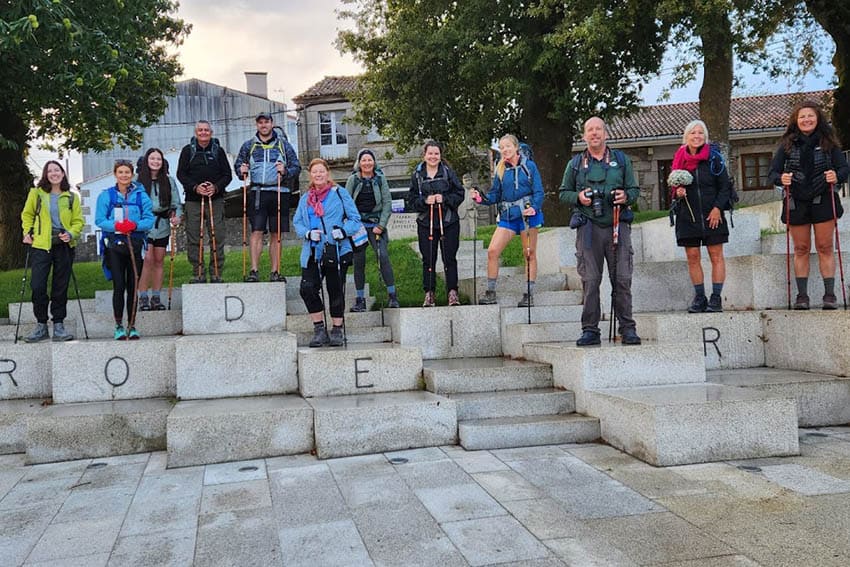A Moving Visit to the Cathedral in Galicia, Spain
By Paul Shoul
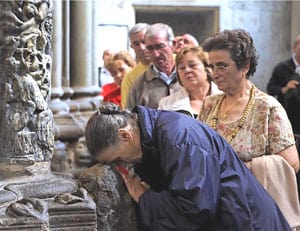
The Cathedral of Santiago de Compostela in Galicia Spain caught me by surprise.
I am not a religious person and I had expected to dutifully take a look around, smile, nod, try to look thoughtful, and then get out as fast as I could back to the streets, food, and the people of Spain that I had come to love during the past week’s journey.
But now, standing under vaulting arches of golden filigree, in a cloud of incense and surrounded by the hum of a thousand pilgrims drawn to this place from all over the world, I am moved.
Unconsciously, I find myself kneeling. It demands my respect and attention and exudes spirituality beyond religion. It is history alive.
The Way of Saint James
I am a traveler awash in a sea of other travelers. As I watch them, I begin to wonder about their stories and from where and why they came here. Some believed that the patron Saint of Spain, the Apostle St. James the Great is buried beneath the Cathedral.
The Camino de Santiago (The way of Saint James) is more than a thousand years old and is one of three Christian pilgrimages during which all sins are thought to be forgiven. Others look further back in time to Celtic legends that the walk was a fertility ritual or that Galicia was the gathering point where the dead would follow the sun across the ocean.
For the pilgrims around me during mass in Compostela, their journey is as important as their destination. They must either walk the last 100 kilometers (62 miles), or 200 kilometers (124 miles) if by bicycle. Some even come on horseback.

All across Europe, there are little yellow signs marking the route to Compostela The pilgrims are issued a “passport” which allows them cheap lodging along the way at various hostels (“refugios”) and must be stamped at each one. This is then presented at the Pilgrim’s office in Santiago where they will receive a certificate of their journey.
Throughout the town, there are posters with an image of two swollen feet that reads, “No pain no gain.” What I don’t feel in religious solidarity with them, I do as a fellow traveler. Before I leave the cathedral I am drawn into a group hug with a bunch of folks from Brazil. No one is a stranger here.
The Land of a Thousand Rivers
Santiago de Compostela is the capital of Galicia, an autonomous community of Spain located in the Northwestern Iberian peninsula. It is also known as the land of a thousand rivers, and I crossed over the Douro River (the river of gold) at the border with Portugal.
The Way of Saint John is not the only route or reason to travel here. With more than 1000 kilometers (620 miles) of coastline, 750 beaches, many with a blue flag rating for the purity of the water, amazing seafood, great local wine, medieval cities, 2000 years of history and the pure enthusiasm for life of the Galician people, it has a lot to offer.
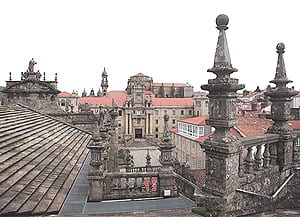
There are two official languages, Spanish and Galician (Gallego), which is very close to Portuguese. Many Galicians feel closer to Portugal than to the rest of Spain. Their culture is more Celtic than Latino. They even play bagpipes called “Gaitas.”
“An Opinionated People”
But whereas the Portuguese are a calm and reserved people, the Galicians are intense and passionate. They were the last part of Spain to be conquered by the Romans. The former dictator of Spain General Franco and Cuban leader Fidel Castro are both sons of Galicia.
“We are,” my Galician friend Jesus said to me, “a very opinionated people.”
They say a Galician never answers with a simple yes or no. Arguing is their national pastime. Miguel, a Portuguese friend of mine explained it this way:
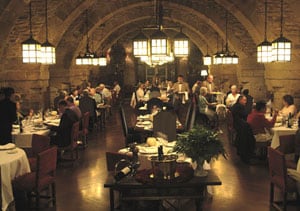
“We [Portugese] are reasonable people. When we are right, we are right. Those Galicians on the other hand, can never be wrong.”
Meals in Galicia can last for hours; they are loud affairs full of long heated discussions and lots of wine. You want these guys as your friends.
The Other Religious Activity
After a rooftop tour of the cathedral and a walk through the ancient streets of the town. My friends and I headed out to the other major religious activity of the region…. eating.
A little-known fact is that the first ten Pilgrims who officially register at the beginning of the day receive a free breakfast at the world’s oldest Hotel, The Parador de Santiago de Compostela. Originally a hospital in 1499 it gave medical help and shelter to the pilgrims. Now a five-star hotel and restaurant, it is located directly across from the cathedral and is spectacular.
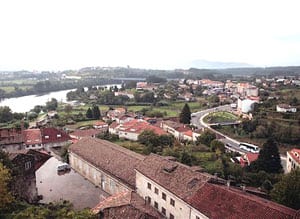
The president has a permanent room there and the atmosphere and food are amazing. I had dinner there on my last evening in town, which was stupendous but lunch earlier in the day typifies why I love Spain and what keeps me coming back.
We ate at the Restaurante O 42 (Rua do Franco 42:tel 34-981-57-06-65). Like all restaurants in Spain, they offer a three-course “ menu de la casa” that is always reasonably priced, usually between 7 and 15 euros.
We had a tapas lunch (small side dishes) that lasted well over three hours. In Galicia, they serve “raciones,” which are slightly larger than tapas, but still not a full, meal-sized portion. That means you order a variety, and pass them around They cost an average of four euros.
Here’s the menu for the lunch: crusty bread, cheese, salad, seafood soup, octopus cakes, fried and salted Padron peppers, tortilla (a thick egg and potato omelet), fried sardines, fried shrimp, shrimp in a garlic sauce, mussels in vinegar and oil, and finally stuffed scallop shells.
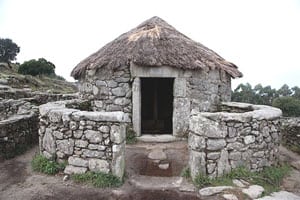
The shells are the sign of the Saint and the Pilgrimage and are a “must-eat.” Add about five bottles of wine, St. James almond cake for dessert, four cups of coffee, many cigarettes, a whole lot of laughter, and it may be the closest thing to heaven to be found on mortal earth.
Places to see, where to stay, and what to eat:
I entered Spain from Portugal and wound my way to Santiago de Compostela. Here are a few suggestions for stops along the way.
Tui
Spain.com
Check out the Town of Tui, just over the border with Portugal. The town is built around the Gothic Tui cathedral. The museum, altars, and organ inside are beautiful, but the highlight for me was the short hike up the ancient stone stairway to the castle tower that offers a great view of the Mino River and of the Portuguese town of Valenca and its castle just on the other side of the river.
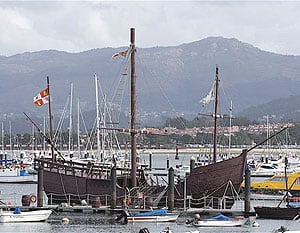
Santa Tegra
Castro de Santa Tegra
Close by to Tui is Santa Tegra. The restaurants on the top of this mountain park are perched on a cliff overlooking the coastline and are a great place to sit and have a tapa or two. (Try the mussels).
Halfway up the road to the summit is one of the best-preserved examples of Celtic settlements called “castros.” This closely packed walled settlement of round stone houses can be dated back to the 1st century B.C.
Celtic settlements are often found on high ground in places that were easy to defend and offered a view of the surrounding area. They chose the choice spots and this is definitely one of them and well worth the trip.
Baiona
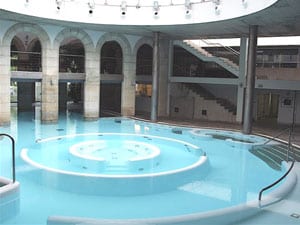
In the center of the harbor of this coastal city is a replica of “Carval La Pinta” the fastest of Columbus’s three ships and the first to return home with news of the discovery of America in 1493. You can visit the floating museum with replicas of the crew on board and the Native Americans they brought back.
I had lunch at the Parador Baiona located inside the Monterreal Castle. There are 84 paradores in Spain that are all situated in locations that are beautiful or castles, monasteries and palaces of historic significance. These are luxury hotels that are affordable by international standards. The rooms here were quite nice and start at $153 a night. The main dining room is elegant, spacious and the food was amazing.
Mondariz Balneario
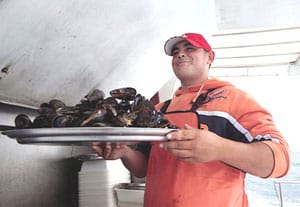
I stayed in the four-star Hotel Balneario de Mondariz about 75 miles from Santiago de Compostela in the tea valley and the Province of Pontevedra. This 194-room hotel and restaurant is worth a stay just for the food and accommodations but is a destination in and of itself for the amazing Water Palace (Palacio del Agua).
The therapeutic mineral waters of the area have been drawing people here for centuries. Their curative powers are said to help digestive disorders if you drink them and heal your body if you soak in them.
The water palace is a huge, indoor, and outdoor facility that also has saunas, steam rooms, and a gymnasium. This place is great.
Pontevedra, Combarro, O Grove
The town of Pontevedra is the capital of the province and has a wonderful historic section. The main square has a large fountain around which are many outdoor cafes and down the winding stone streets, you will find plenty of cool little bars. This place is steeped in history and has a lot to offer.
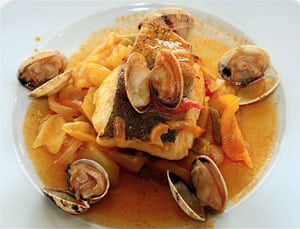
My next stop was Combarro. A delight full little fishing village, but my trip to the O Grove harbor was definitely one of my favorite travel experiences.
Galicia is famous for its seafood and is considered the seafood capital of Spain. It is the second-largest producer of shellfish in the world. The variety is amazing. Octopus, blue lobsters, crabs, fish, shrimps, clams oysters, and mussels are abundant and delicious.
We took a catamaran trip out to view the mussel farm platforms in the harbor. The boat has an underwater viewing area where you can see the long lengths of rope around which thousands are attached.
On the trip back, the crew prepared massive platters of steamed mussels cooked simply with white wine, lemon juice and a little garlic. I’ve eaten in some of the best restaurants in the world but would rate this as one of my favorite culinary adventures. They were pure, clean, and incredibly flavorful and I could not stop eating them. You have to check this out.
A minute away over a bridge is the Isla De La Toja. This home to one of Spain’s most visited hotels The Gran Hotel Hesperia La Toja, and the fabulous restaurant “Los Hornos.”
The Hake stew served with clams I had for lunch was perfect. The little island is also home to the Capilla de San Sebastian. This chapel is covered completely with scallop shells that are used like shingles that visitors write their names and short messages on. It is very cool.
Santiago de Compostela details:
I stayed just ten minutes away from the chapel at the very modern and comfortable five-star Hotel NH Obradoirio. This hotel has everything that you would expect in this price range. The rooms were well done, the bed was one of the most comfortable that I had slept in during my trip and the breakfast buffet was huge.
The staff was super nice and let me use their computer. Except for the fact that I had to use my travel tool kit to open the locked windows to let some fresh air, in, I loved this place.
Read about more pilgrims both sacred and profane in Paul Shoul’s story,
“A Pilgrimage Begins at Home: Forrest Gump, Quasimodo and the Weary Wanderer”
Eurail Passes: What to Know about Buying a Europe Train Pass
- Everything is Better in Lisbon - March 1, 2024
- Exploring Gran Canaria in the Canary Islands - October 17, 2023
- Traveling Lanzarote: Hot Times in the Canary Islands - June 28, 2023


